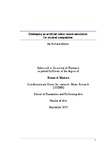Developing an artificial colour-sound association for musical composition
| dc.contributor.supervisor | Miranda, Eduardo | |
| dc.contributor.author | Abbott, Richard | |
| dc.contributor.other | Faculty of Arts, Humanities and Business | en_US |
| dc.date.accessioned | 2018-03-22T12:16:44Z | |
| dc.date.available | 2018-03-22T12:16:44Z | |
| dc.date.issued | 2018 | |
| dc.identifier | 393481 | en_US |
| dc.identifier.uri | http://hdl.handle.net/10026.1/11158 | |
| dc.description.abstract |
Some great composers - Messiaen, Scriabin, Liszt in exemplum - have been found to have an internal colour world that responds to music and characterises the way they experience and express music. Many of these artists, it could be strongly argued, had the neurological trait synaesthesia. The author, a non-synaesthete, creates a logical correspondence between colour and sound and uses it to explore the tonality of aesthetic colour combinations in nature and modern life. He argues that if the colour-sound practitioner is consistent in their colour-sound association, they can benefit in harmonic discoveries as the synaesthete does. It was found that the harmonies produced were strange, new tonalities that do not repeat in each octave but form something akin to macro-chords, shifting density in different registers. The author produced a series of short scores for small ensembles to explore the possible merits of drawing harmony in music from harmony in colour. | en_US |
| dc.language.iso | en | |
| dc.publisher | University of Plymouth | |
| dc.subject | Synaesthesia | en_US |
| dc.subject | Synesthesia | |
| dc.subject | Synposia | |
| dc.subject | Colour | |
| dc.subject | Sound | |
| dc.subject | Cross-modality | |
| dc.subject | Composition | |
| dc.subject | Harmony | |
| dc.subject | Tonality | |
| dc.subject.classification | ResM | en_US |
| dc.title | Developing an artificial colour-sound association for musical composition | en_US |
| dc.type | Thesis | |
| plymouth.version | publishable | en_US |
| dc.identifier.doi | http://dx.doi.org/10.24382/718 | |
| dc.rights.embargoperiod | No embargo | en_US |
| dc.type.qualification | Masters | en_US |
| rioxxterms.version | NA |
Files in this item
This item appears in the following Collection(s)
-
01 Research Theses Main Collection
Research Theses Main


